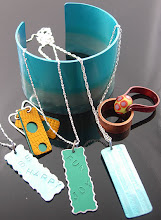This is an article I wrote quite some time back and thought you may enjoy reading it:
My devotion to glass is insatiable, it's molten state has an almost hypnotic effect on me. From a solid strip of glass on a hot flame, it becomes molten in front of your eyes and can then be manipulated by the artist to produce a beautiful intriguing lampwork bead. The bead may then become an integral part of a piece of jewellery, worn proudly for many years and passed down as a heirloom for generations to come.
It has been recorded in history the earliest form of glass beads discovered were made around 3000bc. These beads were used mainly for trade. In the late 1200's Venice became the major city for bead artists when the production was moved to the island of Murano.
Lampwork beads were made directly from a furnace. A mandrel (wire) was dipped into the crucible of molten glass and wound around the mandrel. Further progress was made by the Venetians who used an oil lamp connected to bellows. The pumping of the bellows added oxygen to the flame in order to increase the heat sufficiently to melt a glass rod which would be wrapped around a mandrel to form the bead.
Today, as a lampwork artist my method of making glass beads does not differ greatly from the 1500’s. There is no longer the need to pump bellows to gain the desired heat, instead a bench burner is attached to a source of both gas and oxygen. These fuels mixed together produce a very hot flame in which the glass is melted and wrapped around a stainless steel mandrel coated with a bead release to prevent the bead from sticking.
The intricate designs seen on many lampwork beads are made in a variety of methods. A great deal of decoration is created by pulling a thin thread of molten glass called a 'stringer'. The stringer is then added to the bead whilst in the flame in dots or lines to form many different patterns.
There are quite a few major manufacturer’s producing glass rods specifically for lampworking. It is very important that the glass used in a bead is of the same coe - coefficient of expansion. This means the glass must be compatible with one another so that they expand and contract at the same rate, if not, cracking will occur. In many cases 2 glasses from different manufacturers or even the same manufacturer may not be compatible. My lampwork techniques are a little different in that I prefer to use compatible sheet glass which I cut into strips. This source allows me to work with a wider colour palette.
Some amazing effects can be experienced with the inclusion of fine silver wire. When added between 2 layers of glass the silver will often result in a gold colour, whilst on the surface will retain it's silver effect. Leafs or foils of silver, gold, palladium and copper also add to the uniqueness of a lampwork bead. A new design can be discovered every day along with different shapes and intriguing sculptures.
The durability of a lampwork bead is often a question asked, after all it is made from glass. All lampwork beads with no exception should be put through an annealing cycle immediately after it is taken out of the open flame. This is achieved by placing the bead into a preheated kiln at approximately 530ºc/985ºf , this temperature may alter slightly according to the type of glass used. My beads remain in the kiln until I have completed creating for the day (approx. 7 hours), left at that temperature for another hour, then switched off where my well insulated kiln will slowly reduce the temperature over the next 9 - 12 hours. The annealing process eliminates any stresses in the bead to give it a more stable condition.
Lampwork beads are miniature canvasses of art. They are a conversation piece that will always fascinate. Lampwork beads are meant to be touched and admired as wearable art, a focal point of an item or showcased as a collector's specimen.





No comments:
Post a Comment